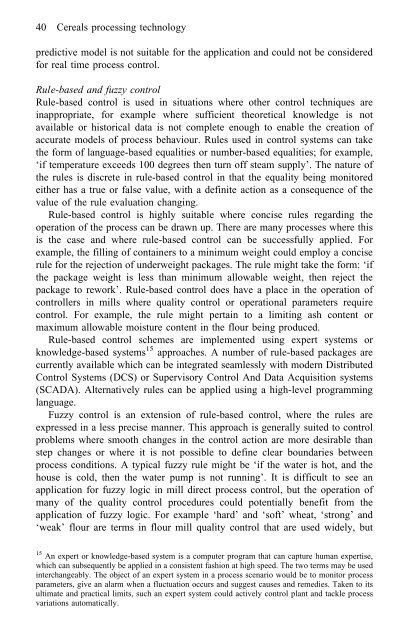Cereals processing technology
Cereals processing technology
Cereals processing technology
You also want an ePaper? Increase the reach of your titles
YUMPU automatically turns print PDFs into web optimized ePapers that Google loves.
40 <strong>Cereals</strong> <strong>processing</strong> <strong>technology</strong><br />
predictive model is not suitable for the application and could not be considered<br />
for real time process control.<br />
Rule-based and fuzzy control<br />
Rule-based control is used in situations where other control techniques are<br />
inappropriate, for example where sufficient theoretical knowledge is not<br />
available or historical data is not complete enough to enable the creation of<br />
accurate models of process behaviour. Rules used in control systems can take<br />
the form of language-based equalities or number-based equalities; for example,<br />
‘if temperature exceeds 100 degrees then turn off steam supply’. The nature of<br />
the rules is discrete in rule-based control in that the equality being monitored<br />
either has a true or false value, with a definite action as a consequence of the<br />
value of the rule evaluation changing.<br />
Rule-based control is highly suitable where concise rules regarding the<br />
operation of the process can be drawn up. There are many processes where this<br />
is the case and where rule-based control can be successfully applied. For<br />
example, the filling of containers to a minimum weight could employ a concise<br />
rule for the rejection of underweight packages. The rule might take the form: ‘if<br />
the package weight is less than minimum allowable weight, then reject the<br />
package to rework’. Rule-based control does have a place in the operation of<br />
controllers in mills where quality control or operational parameters require<br />
control. For example, the rule might pertain to a limiting ash content or<br />
maximum allowable moisture content in the flour being produced.<br />
Rule-based control schemes are implemented using expert systems or<br />
knowledge-based systems 15 approaches. A number of rule-based packages are<br />
currently available which can be integrated seamlessly with modern Distributed<br />
Control Systems (DCS) or Supervisory Control And Data Acquisition systems<br />
(SCADA). Alternatively rules can be applied using a high-level programming<br />
language.<br />
Fuzzy control is an extension of rule-based control, where the rules are<br />
expressed in a less precise manner. This approach is generally suited to control<br />
problems where smooth changes in the control action are more desirable than<br />
step changes or where it is not possible to define clear boundaries between<br />
process conditions. A typical fuzzy rule might be ‘if the water is hot, and the<br />
house is cold, then the water pump is not running’. It is difficult to see an<br />
application for fuzzy logic in mill direct process control, but the operation of<br />
many of the quality control procedures could potentially benefit from the<br />
application of fuzzy logic. For example ‘hard’ and ‘soft’ wheat, ‘strong’ and<br />
‘weak’ flour are terms in flour mill quality control that are used widely, but<br />
15 An expert or knowledge-based system is a computer program that can capture human expertise,<br />
which can subsequently be applied in a consistent fashion at high speed. The two terms may be used<br />
interchangeably. The object of an expert system in a process scenario would be to monitor process<br />
parameters, give an alarm when a fluctuation occurs and suggest causes and remedies. Taken to its<br />
ultimate and practical limits, such an expert system could actively control plant and tackle process<br />
variations automatically.



